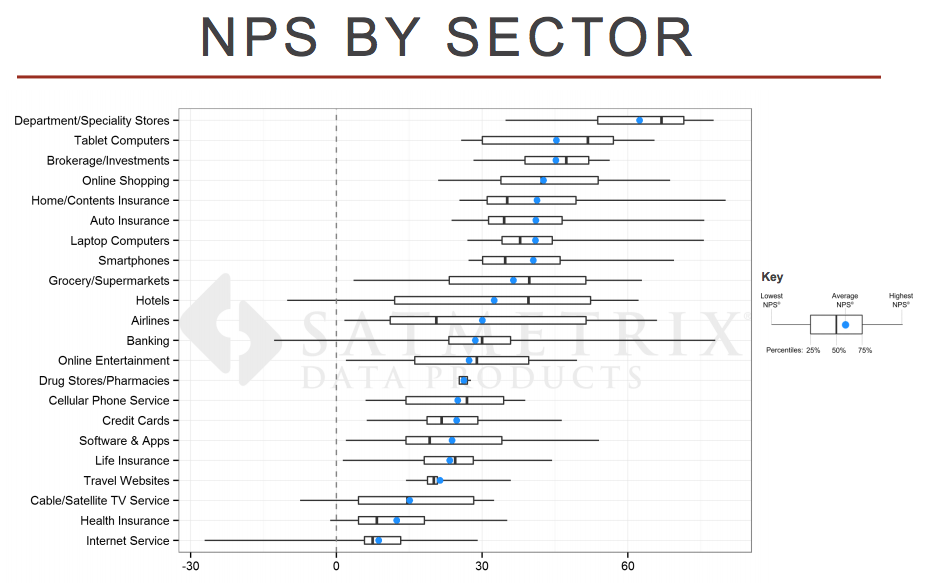Measuring customer loyalty is tough. Sure, you can look at purchase history, but in many industries, enthusiasm and spending habits are not always related.
Just look at phone companies – happy and unhappy customers alike pay a set rate every month. Without additional information, how could you differentiate between a satisfied customer and one who’s about to jump ship?
But companies have an incentive to measure customer loyalty: research shows that loyal customers – especially customers who refer their friends – are far more valuable than complacent customers.
So, companies have turned to surveys and evaluation metrics to determine just who those loyal customers are, and what makes them so loyal. One of those metrics is the “Net Promoter Score,” or NPS.
NPS is derived from a single question asked of all customers who respond to your brief survey.
Using NPS to Categorize Customer Loyalty
NPS was developed by Fred Reichheld, Bain & Company, and Satmetrix Systems as a means of measuring customer loyalty. To be exact, the net promoter score measures the loyalty that exists between provider and customer. Reichheld et al. studied which questions were the most accurate predictors of customer loyalty, and finally settled on one.
The NPS survey consists of a simple question:
“How likely is it that you would recommend our company to a friend?”
The customer then chooses a number between one and ten, with one being the worst score possible and ten being the best you can get. Customers are then grouped into three categories: detractors, passives, and promoters.
😍 Promoters
Promoters are the customers who rate your company at a 9 or a 10. These customers think your company is an all-star and they’re ready to spread the word to their friends. If they aren’t already talking about you, you can usually motivate them to help you with targeted marketing. They may have ideas about how to make your service even better. Promoters are worth identifying so you can listen to their feedback and leverage their social influence.
😌 Passives
Passive customers rate your company at a 7 or 8 on the survey. These people are neither very dissatisfied or very satisfied. They aren’t likely to actively promote your company to their friends, but they aren’t likely to go around telling terrible stories about you, either. Fortunately, this group is the easiest to convert to ‘promoter’ status; make them just a little bit happier, and they could become your most loyal fans.
😤 Detractors
Anyone who rates your company at a 6 or below is considered a detractor. These are the customers most likely to spread negative feedback about your company and least likely to provide repeat business. It’s worth learning as much as you can about what went wrong so that you can reach out to those dissatisfied customers and prevent those problems from occurring in the future.
Calculating NPS
Once you’ve categorized your customers, you can calculate your net promoter score. First, determine what percent of your responders are promoters, and what percent are detractors. Subtract the %detractors from the %promoters, like this:

Once you’ve done the subtraction, you can drop the percent sign. This is your raw NPS. Since you can’t have more than 100% promoters or fewer than 100% detractors, your score range lies between -100 and 100. A slightly negative score is common at first, but with work most companies can maintain a positive NPS. The chart below shows some benchmark NPS information arranged by industry. You can use these industry benchmarks to see how you’re doing relative to your competition.

2013 US Consumer Data. Source.
Strengths & Weaknesses of NPS
NPS is useful because it is a fast, approximate measurement of how loyal your customers are. Since it’s a single-question survey, you’ll have a much higher completion rate than surveys that require longer responses. However, the brevity and subjectiveness of the question also leave something to be desired.
For example, the survey does not take into account variations between each person’s numerical concept of what’s worth recommending. To some people, a five is neutral and anything better is likely to result in a referral. But for the survey, a score of 5 is solidly in detractor territory.
Another problem occurs if you take industry benchmarks too seriously. While they can be helpful in giving you a general goal, results can vary substantially based on industry, country, and methodology.
NPS is much better at giving you a starting point: a rough sketch of who your happiest customers are so that you can learn from and harness their enthusiasm for your company. It’s also a great way to start measuring your customer relations and you can use your initial number as a benchmark for future improvement.
In addition to the number rating, responders can explain what factored into their score. So, it’s useful to read their comments to understand what aspects of your service are disappointing or satisfying. For example, you may find that many responders who rate your company below 5 often do so because they felt customer service agents didn’t fix their problems. That would lead you to investigate the accuracy and timeliness of your rep’s responses to inquiries.
NPS & Simplesat
As a stand-alone concept, NPS is helpful, but it still leaves a lot of unknowns. We find that it’s much more useful when combined with other survey methodologies, such as the RATER metric. Not only can you roughly identify who your promoters and detractors are, but you can also quickly peg why they’re promoters or detractors. When you have information on which service metrics are influencing your NPS, it’s much easier to determine your next course of action. And that’s one step closer to happier customers and a healthier company.













